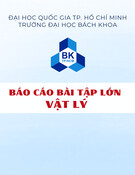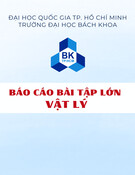Quang phổ Laser
DÙNG PHỔ RAMAN VÀ PHỔ QUANG PHÁT QUANG
NGHIÊN CỨU ẢNH HƯỞNG CỦA TỈ LỆ KHÍ OXY VÀ SỰ Ủ NHIỆT ĐỐI VỚI MÀNG TIO2 CHẾ TẠO BẰNG PP PHÚN XẠ MAGNETON PHẢN ỨNG
Quang phổ Laser
MỤC ĐÍCH:
Nghiên cứu sự ảnh hưởng của tỉ lệ dòng oxy đưa vào trong hệ phún xạ trong việc chế tạo màng
Nghiên cứu sự ảnh hưởng của nhiệt độ ủ trong quá trình hình thành cấu trúc của màng
Quang phổ Laser
GiỚI THIỆU:
Chế tạo màng TiOx bằng phương pháp phún xạ magneton trực tiếp ở nhiệt độ phòng với tỉ lệ dòng oxy đưa vào khoảng 3-15%
2
100%
FO % 2
FO FO FAr
2
Sau đó đem ủ nhiệt ở 350-750oC
Dùng phổ nhiễu xạ tia X, quang phát quang và phổ Raman để nghiên cứu tính chất của màng
Quang phổ Laser
THÍ NGHIỆM:
Dùng đế p-Si(100), làm sạch bởi H2SO4 và H2O
Target Ti tinh khiết 99.99%, đường kính 2in và được áp vào nguồn DC 100W
Đế được áp điện thế -150V
Khoảng cách giữa đế và bia là 100mm
Áp suất nền 2.7*10-4 Pa, Áp suất làm việc 2.7*10-4 Pa
Thời gian phún xạ 40 phút
Độ dày của màng từ 50-200nm
Quang phổ Laser
ĐO TÍNH CHẤT MÀNG:
Cấu trúc màng, thông tin phase (anatase hay rutile) đo bởi quang phổ kế tia X sử dụng bức xạ Cu Kα (0.1542nm). Made in Japan
Các liên kết được đo bởi phổ Raman. Made in France
Phổ PL dùng laser He-Cd 325nm 50mW, cách tử và CCD
Quang phổ Lazer
LabRAM HR UV/Vis/NIR
+ Ar ion CW Laser (514.5nm, 488nm) upto 40mW at sample. + He-Cd CW Laser (325nm) -Auto motor controlled XY mapping stage
Anatase
Rutile
Quang phổ Laser
Anatase
Rutile
Paints, and Coating , emulsion
APPLICATION 1- interior Paints, Enamels 2- Road-Marking Paints Filler , Primers, and undercoat 3- Paper Industry 4- 5- Plastic Industry 6- Rubber Industry 7- Cement Industry.
widely used in painting, printing oil paper making Plastic Rubber artificial fiber (sợi quang nhân tạo) welding electric (hàn điện) Enamel (tráng men) electric appliances and construction material etc
RESULTS AND DISCUSSION
crystalline
peak denoted (101) as
GIXRD patterns of titanium oxide films formed at: 3, 6, 10 and 15 FO2% and post-annealing at 750 °C for 2 min in air _ The deposition time was fixed at 40 min. The _ anatase A(101) at 25,3°. _ rutile peak The (110) denoted as R(110) at 27.4° can be easily observed from the TiOx thin film formed at 3 FO2%. _ The intensity of anatase peaks at 3 FO2% is stronger than rutile peaks. _ As FO2% is higher than 6%, the rutile peaks cannot be detected.
RESULTS AND DISCUSSION
_ TiOx film annealed at 350°C is still an amorphous film because of no distinct diffraction peak.
_ The mixed crystalline anatase and rutile films are obtained after 550°C and 750°C annealing.
_ The intensity of both anatase and rutile peaks increases with increasing temperature.
GIXRD patterns of titanium oxide films formed at: 3 FO2% and post-annealed at RT, 350°C , 550°C , and 750°C for 2 min in air.
RESULTS AND DISCUSSION
_ The film at 3 FO2% shows several anatase peaks at 396 and 639 cm−1 and rutile peaks at 449 and 612 cm−1.
_ The rutile peaks decrease with increasing oxygen flow ratio.
_ The intensity of anatase peak decreaseswith increasing oxygen flow ratio due to the reduction of film thickness.
Raman spectra of titanium oxide films formed at 3, 6, 10 and 15 FO2% and post-annealed at 750 °C for 2 min in air.
RESULTS AND DISCUSSION
_ The intensity of anatase peaks at 396 and 639 cm−1 and rutile peaks at 449 and 612cm−1 increases with annealing temperature from RT to 750°C, especially for anatase peaks.
Raman spectra of titaniumoxide films at 3 FO2% and post- annealed at RT, 350 °C , 550 °C , and 750 °C for 2 min in air.
RESULTS AND DISCUSSION
The relationship between the crystalline structure and PL behaviors of titanium oxides
Laser excitation: 325 nm, at the room temperature _ The weak shoulder peak at 650 nm is induced from the laser source. asymmetrical wide _ An FWHM peak in visible region is observed at the 3 FO2% sample.
PL spectra of titanium oxide films formed at 3, 6, 10 and 15 FO2% and post-annealed at 750 °C for 2 min in air.
RESULTS AND DISCUSSION
_ The wide peak is merged from two different TiOx peaks.
_ The curve can be fitted into two Gaussian peaks at 486 nm (2,55eV) and 588 nm(2,11eV).
The Gaussian fitted curve of PL spectra of the 3 FO2% film at 750 °C annealed for 2 min in air.
RESULTS AND DISCUSSION
because
_ Luminescence shift caused by the mixed anatase and rutile phase. _ The intensity of PL peaks increases annealing with of temperature enhancement of the crystalline phase. _ For the as-deposited and 350 °C annealed samples, the PL signal is very weak due to the poor crystallinity.
PL spectra of titanium oxide films at 3 FO2% and post-annealed at RT, 350 °C , 550 °C , and 750 °C for 2 min in air.
CONCLUSION
The oxygen flow ratios during deposition and post-annealed temperatures result in the evolution of phase formation of the films
The XRD and Raman results indicate that the 3 FO2% film is formed of a mixed phase of anatase and rutile, and the specimens of 10 FO2%, and 15 FO2% are the single-phase anatase after 550–750 °C annealing
The as-deposited TiOx films and those annealed at 350 °C are all
amorphous because of no distinct diffraction peak.
The minimum thermal annealing temperature necessary to
stimulate the crystallization of film is between 350 °C and 550°C.


























